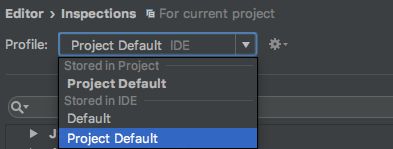本文主要讲述两个方面:
1)为何制定Radio_Inspections 规范及实操
2)IDE Inspection 使用
第一部分 :为何制定Radio_Inspections 规范及实操
一 、制定Radio_Inspections 规范的目的
(1)写代码时发现并解决不规范的书写或潜在的bug (其他工具未扫描出来)
(2)解决部分代码性能问题
二、Radio_Inspections 能够解决的问题
当前虽然IDE Inspection 能够提供实时提示,但是往往开发者没太注意,原因主要有以下几点:
(1)IDE Inspection 默认检查项过多,扫描结果过多,处理费时,不愿处理;
(2)IDE Inspection 提示级别多为warning ,让人容易忽视(有时往往会产生致命np问题);
(3)IDE Inspection 部分检查项,默认关闭的(规则太多,开发者也不会一一浏览过滤);
针对上述三个问题,freddy想出相应对策,来制定符合自身项目的Inspection 规则(Radio_Inspections) :
(1)浏览相关规则,结合平时开发,将部分默认未开启有意义的检查项开启;
(2)将提示级别设置为error ;
(3)优先处理error 级别问题。
Radio_Inspections新增 规则如下(暂时未引入阿里插件检查项):
(1)Class structure
1) Utility class without ‘private’ constructor
工具类 建议添加 私有构造方法,防止实例化
2)Class with only ‘private’ constructors should be declared ‘final'
工具类 建议 添加final 修饰符
(2)Code style issues
1) ‘expression.equals(“literal”) rather than “literal”.equals(expression)
防止潜在np
(3)Control flow issues
1) Unnecessary ‘null’ check before ‘instanceof’ expression
(4)Declaration redundancy
1) Access static member via instance reference
(5)Imports
1)Static import
(6)Java language level migration aids
1) Identical ‘catch’ branches in ‘try’ statement (语法糖)
案例:
同时,对应关闭 “Multiple-catch can be split into separate catch blocks”
(7)Memory issues
1)Inner class may be ‘static’
(8)Probable bugs
1)Return of "null"
public 方法返回 null ,建议添加 @Nullable (强制添加,不然提示)
2) equals( ) and hashCode( ) not paired
(9) Inheritance issues
1) @Overridate
(10) Numeric issues
1)Divide by zero
2) 'long' literal ending with "l" instead of "L'
(11) Serialization issues
1)Serializable class without 'serialVersionUID'
2)‘serialVersionUID’ field not declared 'private static final long'
3)Transient field in non-serializable class
防止 transient 关键字 和 @Transient 用混
另外,有一些比较好的建议(暂时未添加):
(1)Performance issues
1)Collection without initial capacity (638+)
设置初始容量
(2) Magic number (1273 个)
建议关闭的默认规则 :
(1)Javadoc issues
直接checkStyle 就可以
(2)General Default File template (模板)
This inspections reports usage of the default file template for File Header.
(3)Syntax error inspection
Allows you to see syntax errors in the results of batch code inspection.
(4)Spelling
(5)Android Lint :Internationlization
1) Using left / right instead of start/end attributes (1640+)
第二部分 :IDE Inspection 使用
一、默认情况 (Project Default)
1)Specify Inspection scope
选择Inspection scope 以及 Inspection profile
Inspections profile 主要有两种存储方式 :IDE (选择IDE即可) 和 project,建议使用IDE 存储,切换分支不会发生变化;
二、规则挑选过滤
Inspection 检查 主要 分为 :Error 、Blocker 、Critical、Major 等等 。可以通过左侧漏斗按钮进行相关过滤。
三、过滤机制
(1)检查结果相关点
右侧对应Suppress 方式 (分别针对 method/class/ all inspections for class),尽可能选择粒度较小的方式,如method 。
(2)具体Method过滤
(3)检查项不配置,则对整个工程都不会检查






